

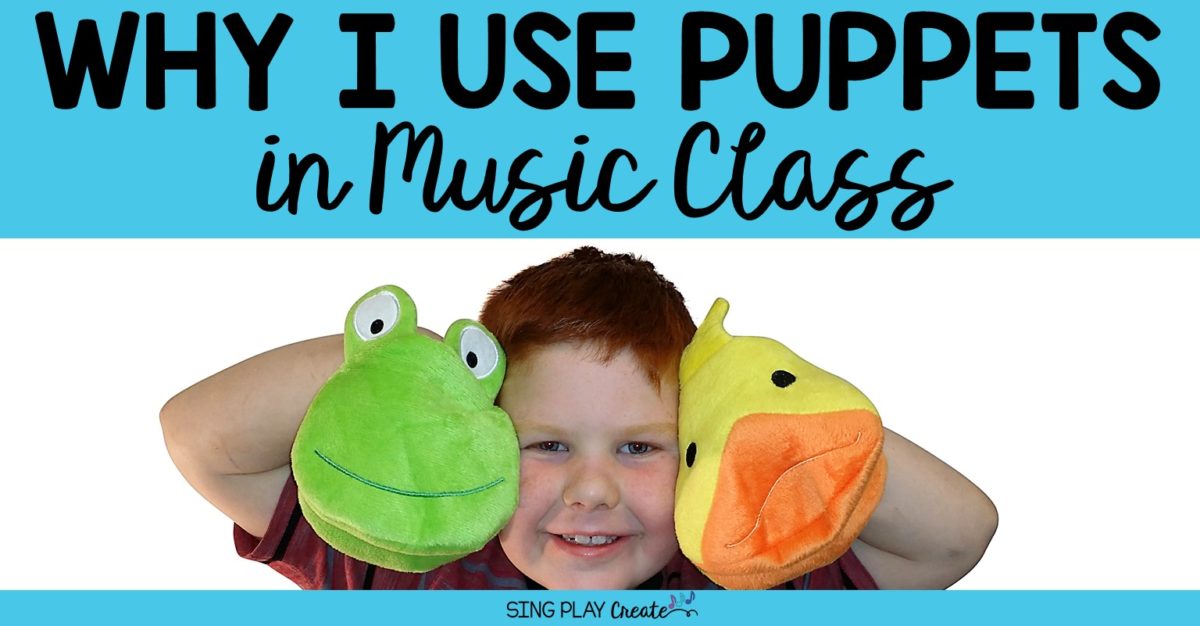
I love using puppets in music class. They make the perfect companion for a music lesson. Why? I’ve found that children’s response grows exponentially when my puppets are teaching anything from music concepts to songs, and even for teaching the rules of the classroom. Puppets are an especially effective tool to use with those students who might need help focusing.
When I pull out a puppet, the puppet takes on a life of it’s own, talking and singing-even cracking jokes! The students love it! And, after finally making it through the first few weeks of procedures, hello songs, seat charts, names and games. I’m ready to move on and get into the meat of preparing, presenting and helping students develop music skills. For me, puppets are an effective way to begin the process of learning and have fun at the same time. And that’s why I use puppets in the music class.
Puppets can sing, talk, whisper, shout, dance, cry, laugh, talk like an animal or imaginary character. They can share feelings of worry and fear, courage, kindness and bullying. Puppets can share and do things that the teacher cannot do. They take students to an imaginary place where they can learn and grow safely. I’ve found great success with them in my classroom and continue to create new ways to use them all the time. Here’s some reasons why I use puppets in music class.
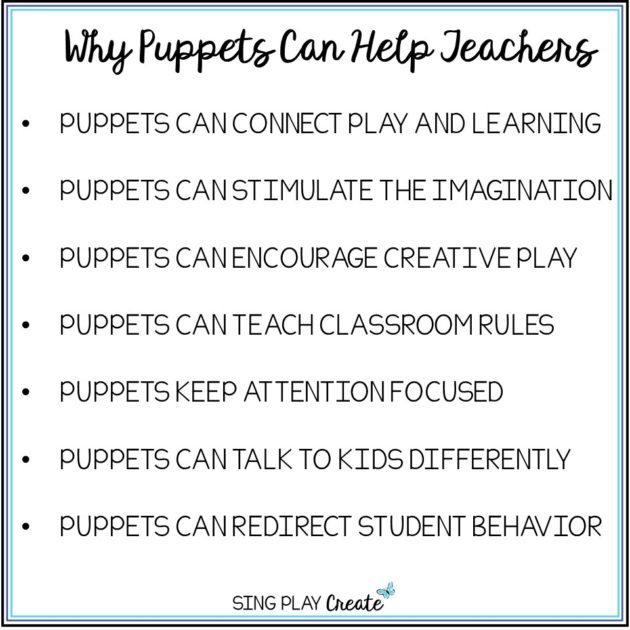
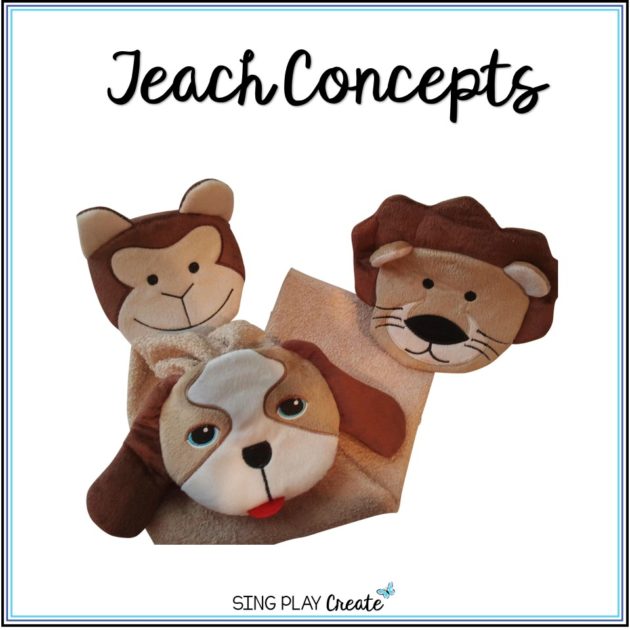
I like to focus in on a specific set of music skills for each grade level over the period of a month. I try to keep the music concepts the same and differentiate by skills. For example; First quarter is about Beat and Rhythm skills. Kindergarten will be introduced to the steady beat, whereas first grade will begin learning to differentiate between beat and rhythm. Each grade has their own “I CAN” statement that falls under the concept I am working on with each grade. It doesn’t always work out perfectly, but usually I’ll have at least three of the grades working on the same concept.
Right now I’m wrapping up Steady Beat in 4/4 and 3/4 Time Signatures. The students have had some fun “feeling” the beat with marching, patting, and connecting visual representations of the beat icons with body percussion activities. Some of the differentiation’s are; Kindergarten and First Grade patting and Clapping to feel Strong and Weak Beats, and in upper grades making Popsicle stick 3 beat patterns in small groups and sharing with the class, or playing smartboard games to review rhythms. You can read about steady beat lesson ideas here: Five Ways to Teach Steady Beat
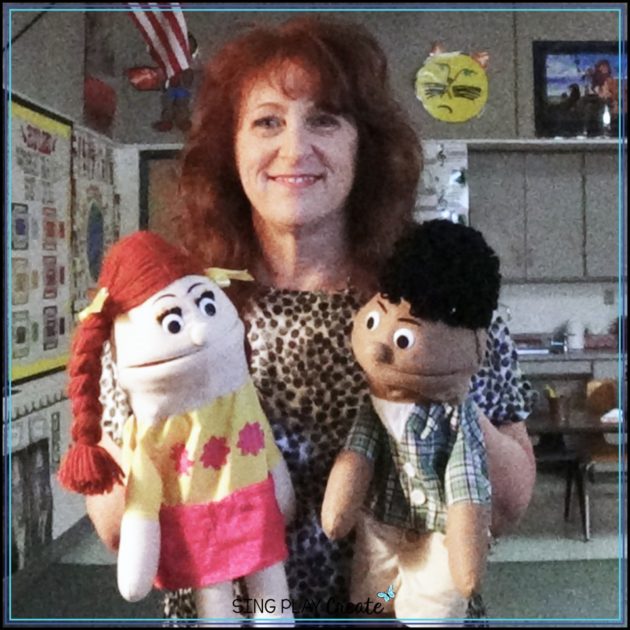
After I introduce Steady Beat, I move quickly to TIMBRE and voice choice lessons. I find it’s helpful to teach TIMBRE at the beginning of the school year as it helps with classroom management and prepares students to learn more later about pitch and singing. I know kids love puppets and will listen to them better than me. So why not use puppets to teach these concepts? When I introduce voice choice lessons I use four different puppets. When I introduce my puppet characters, I give each of them their own voice and personality. It’s easy to do in a voice choice lesson because one puppet sings, one whispers, one shouts and one speaks. Meet my puppets!
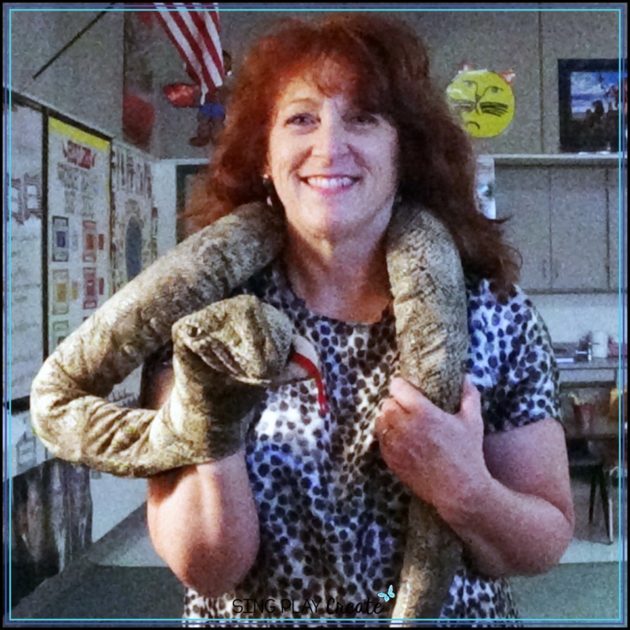
Whisper-Snake puppet: Mr. Snake loves to slither around the library and read booksssssss all day. It’sssssss quiet in the library and so it’s the perfect place to hide. Or he might go into the hallway where everyone walkssss quietly and he can slide along without being noticed.
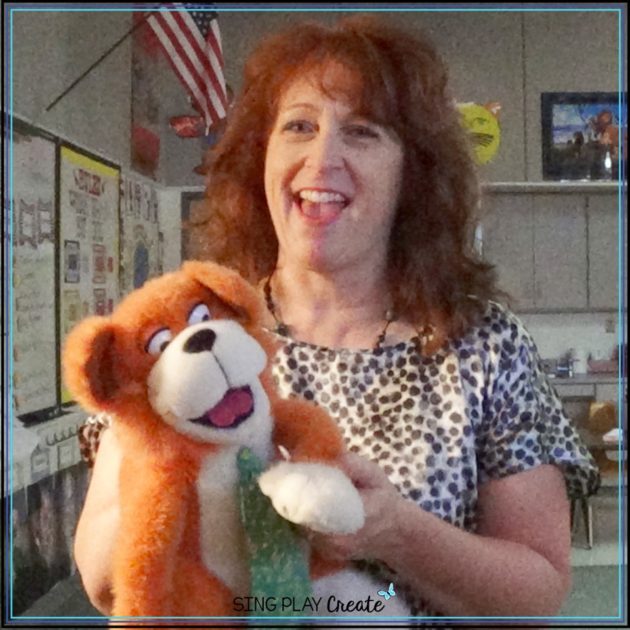
Cat puppet: I use “ARP” the cat. He sings about everything. And he’s of the opinion that cat’s are the best singers in the world. If he’s taking a nap and I have to wake him up he sings his favorite song to the class. (To the Tune of Frere Jacques)
“Milk and cookies, milk and cookies, (repeat)
they are nice (they are nice).
I will eat them every day, (I will eat them every day)
Instead of mice, (instead of mice).
Arp asks for cookies and milk all the time. When the students try to start giving him imaginary cookies he asks them to sit quietly as it’s time to listen and learn how to be a great singer. Then he’ll warm up his voice- meow- meow- meow… and, all of the student’s giggle. He might sing on sol-mi and have them be his “copy-cat”, or he might make up a little song about their names. “I like Johnny, he is nice!”
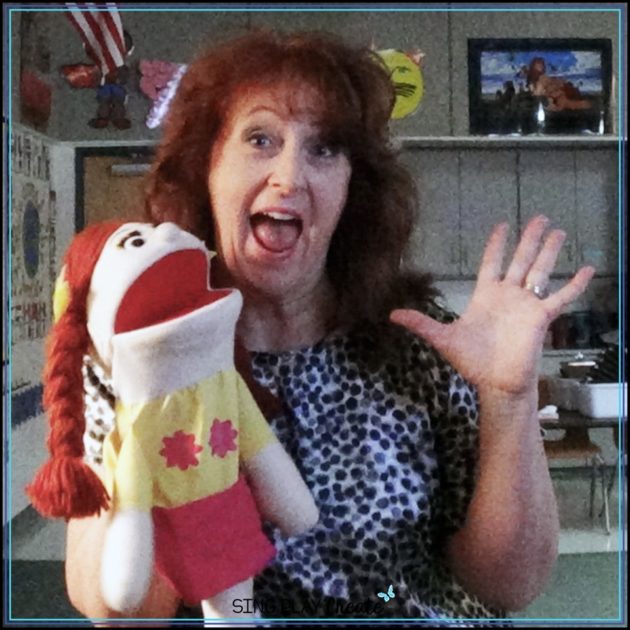
Speak-I use some kid puppets. The boy is “speak”, the girl always shouts. The boy puppet asks the class to help him teach “Janey” how to talk and not shout.
At first Janey just keeps shouting until “Johnny” says; “it takes practice, concentration and breath control.” Janey thinks about that and takes a big breath. Then she slowly mumbles out her words in a quieter voice. I ask the students to clap for her, and of course she shouts; “I DID IT! I DID IT! I DID IT!” and then goes silent for she realizes she just shouted again. Johnny says; that’s okay Janey, remember it takes practice, concentration and breathing, and it’s okay to make a mistake. Janey shouts that recess is her very favorite time of school. I have the class help her practice how to speak instead of shout.
Johnny helps her understand that she can use her shouting voice outside, but needs to keep her voice quiet in the school. And then she practices! It takes her a couple of times and the students even need to deep breathe with her and practice too.
The kids giggle and I let them experiment with the puppets encouragement.
I also have a special song that each character sings. I love this lesson because I don’t have to say “please be quiet”, or “no shouting” in the music room, because Johny and Janey taught it for me.
You can find these songs in my resource:
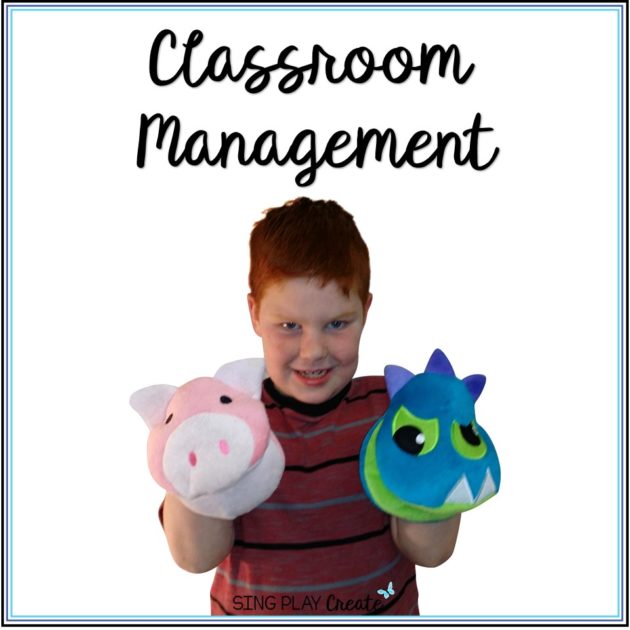
I love this lesson because I don’t have to say “please be quiet”, or “no shouting” in the music room, because Johhny and Janey taught it for me. If we ever need to review- I just bring them back on in to help the students remember the rules. And, I’ve found that especially during the first 6-8 weeks in Kindergarten that some students aren’t quite ready for all of the structure in a full day of school. Many times, I’ve had a student who’s having trouble focusing or following directions and I go and get “ARP” and pick up the lesson with the cat puppet teaching. I move towards the students who’s having a difficult time and have the puppet talk right to that student. It’s worked every time! I see a calmness come over that student and they are back in music land with me! I’ve also used my puppets on the days before and just after the holiday breaks. Puppets can teach and review the rules, goals and expectations in the classroom and students respond better too.
I use puppets to help the students remember the rules. Instead of clapping or playing a drum or frowning or moving the behavior chart marker down- if I go get a puppet and just pause for a minute- I usually can get the class back on track. I will have the puppet ask the class to sit down for an important announcement and then talk to them about the rules or remind them about personal space. Sometimes I’ll have the puppets ask students to get back on the train to music land as some of them have fallen off the train and are going to get left behind. I’ve found that I am calmer and the students calm down pretty quickly when I have a puppet friend.
Usually I’ll come up with a joke or song to change the mood like; “I think I smell my cookies burning! And that means no cookies and milk for anyone today. Oh meow, meow, what am I going to do?” Sometimes I’ll ask students to get back on the train to music land as some of them have fallen off the train and are going to get left behind. Overall, I’ve found that I the students respond so positively to puppets.
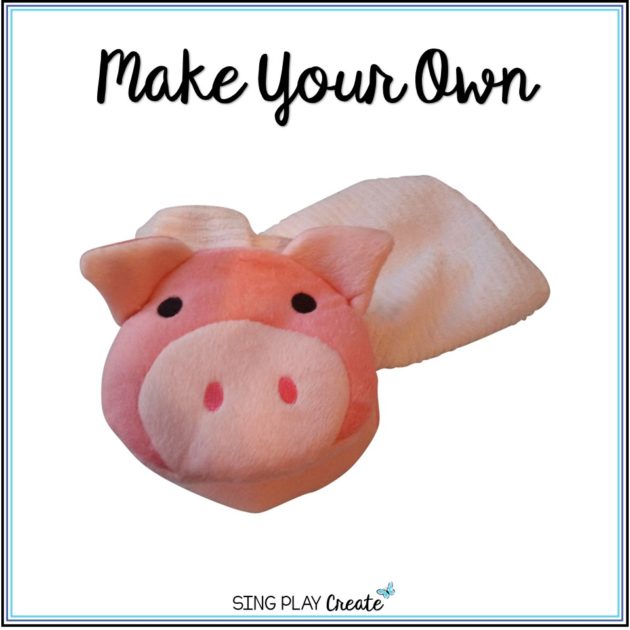
Puppets can be made out socks, paper sacks, old clothes, felt squares, paper and clay. I found these hand washing animals in Wal Mart and turned them into puppets. I just made the sleeve out of a towel. I folded it in half and then sewed down the side so that the tube is open at both ends. That way I can use the same sleeve with many puppets.
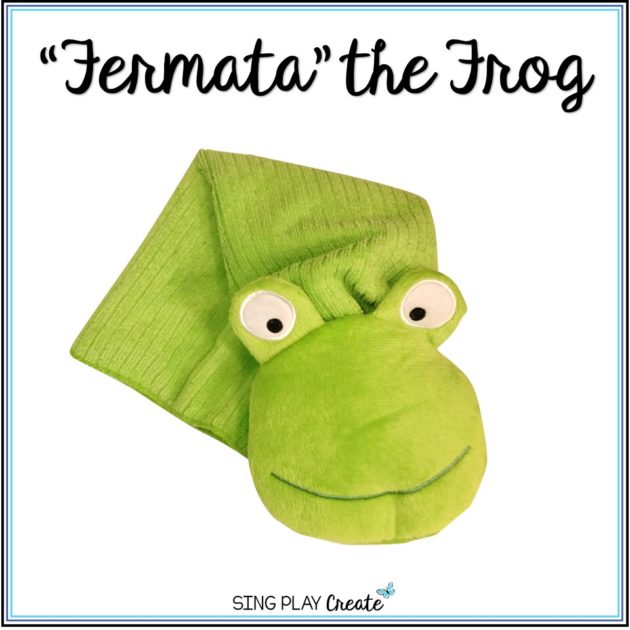
This puppet has become a big hit in my classroom. Without any prior thought, I named her “Fermata the Frog”. I say to the students, “do you know why she’s called Fermata?” They don’t know, and so I ask the puppet to sing their names, and she does-except she doesn’t stop singing until I cut her off with my other hand (musically!) The students are laughing and now I teach them what “fermata” means. The next class time I ask them to help me by conducting Fermata as she sings their names. They love to “cut off” her voice, sometimes short and sometimes long. And have you seen these adorable tennis ball puppets? You could make one for each character in your presentation. Or, try having the 5th and 6th graders make some for the younger students.
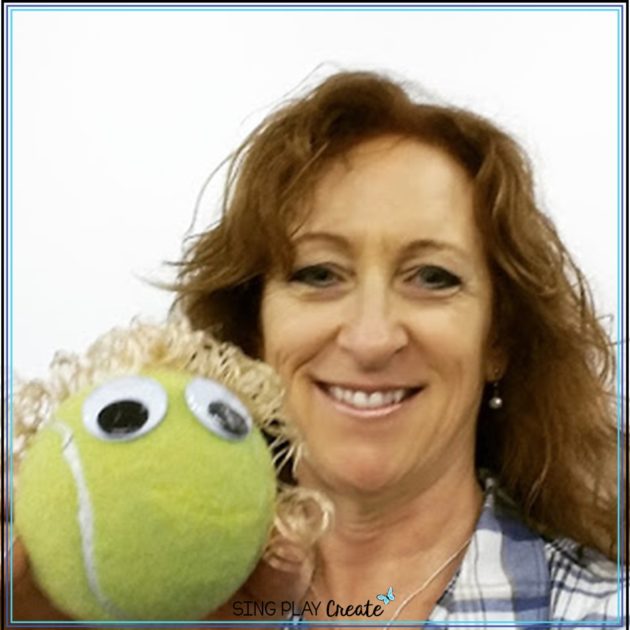
There are so many great things going on when puppets are used in the music room. Kids are actively engaged in listening, analyzing, speaking, singing, moving–which are so important to language development.
These skills are also important for social development. When kids laugh together they learn that they have something in common with the other kids in the class. Their subconscious is telling them “see–you fit in just fine–everyone is laughing and so are you!” And–“it’s okay to laugh!”
Creative experiences in the music room help children be creative too and using puppets inspires student creativity. I think of it like I’m going on a trip. When I use a puppet, I’m taking my students to “music land” to learn “?” and experience “?” in a new way.
I am constantly learning new things about using puppets and found some great video resources that teach exactly what to do with a puppet when talking to children. Here’s some tips I learned:
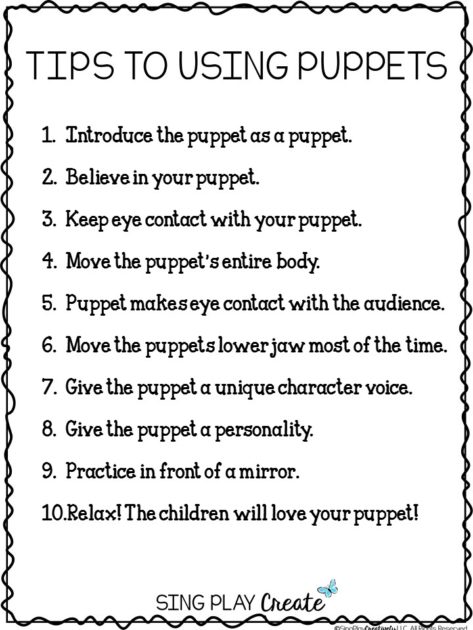
If you’d like a free copy of these tips and ideas, you’ll want to subscribe to my newsletter and FREE RESOURCE LIBRARY. These tips and puppet templates are included in the library. All you have to do is subscribe!
You can watch the video here:
How do you use puppets in music class?
If you’re interested in my resource, you can find it here:
![]()
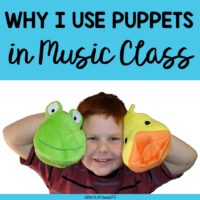
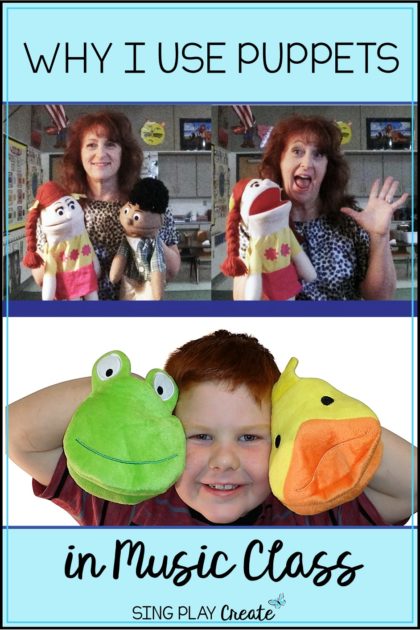

Hi there! I’m Sandra, one of the authors behind Sing Play Create. My goal is to provide teachers with interactive resources and activities to improve the effectiveness of their teaching and enhance student learning.
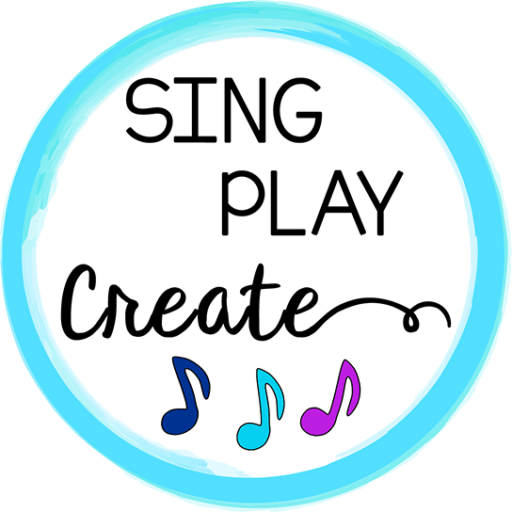
© 2022 Sing Play Create. All Rights Reserved.
4 Responses